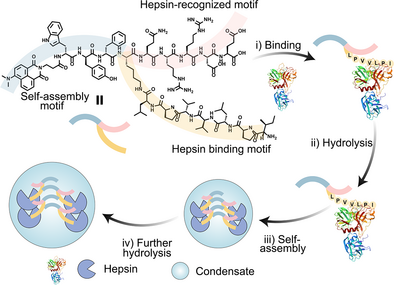Enzyme Induced Solid-Like Condensates Formation of Engineered Peptide in Living Cells for Prostate Cancer Inhibition
Graphical Abstract
This study presents the condensate formation from engineered amphiphilic-branched peptides in living cells through enzymatic reactions. We describe the rational design and synthesis of DMN-SIPL, a peptide that forms solid-like condensates via liquid–liquid phase separation (LLPS) when triggered by the type-II membrane-associated serine peptidase hepsin.
Abstract
This work describes the rational design and synthesis of hepsin-recognized amphiphilic-branched peptides (DMN-SIPL) that can form solid condensates through liquid–liquid phase separation (LLPS) upon enzymatic reaction. The peptide forms solid-like condensates both in vitro and in living cells, triggered by type-II membrane-associated serine peptidase, hepsin, whose overexpression determines prostate cancer progression. Specifically, integrating self-assembly, hepsin hydrolysis, and hepsin-binding domain generates a branched substrate that acts as a precursor for enzyme-induced LLPS. Upon binding hepsin on the cell membrane, DMN-SIPL forms condensates initiated by hepsin-induced self-assembly. The prostate cancer cells then uptake these condensates via lipid raft-mediated endocytosis. The entrapped hepsin in the condensates further hydrolyzes the DMN-SIPL to stabilize the intracellular condensates. Structure–activity relationship reveals the importance of enzyme-binding motif, enzyme-recognized motif, and the self-assembly motif. Mechanistic studies indicate that the resulting solid-like condensates modulate cancer cell metabolism by inhibiting hepsin upstream protein activation and downstream signal transduction, ultimately inducing cancer cell growth inhibition selectively. As a first example, this work investigates enzymatic LLPS condensate formation in living cells, paving the way to generate functional synthetic biomolecular condensates through LLPS for biomedical applications.
Conflict of Interests
The authors has applied a patent based on this work.
Open Research
Data Availability Statement
The data that support the findings of this study are available from the corresponding author upon reasonable request.





